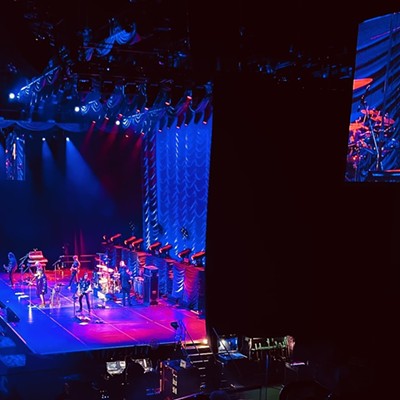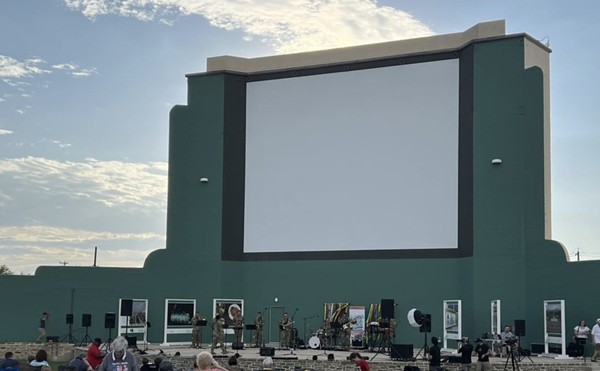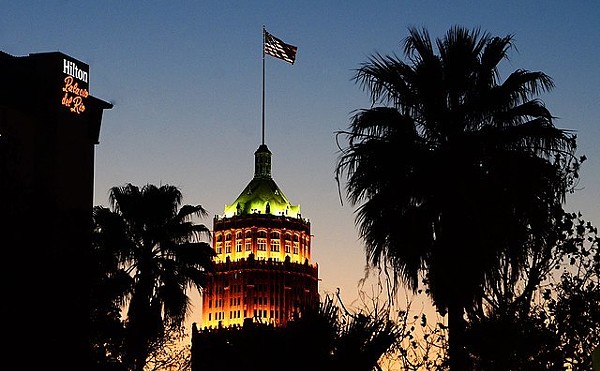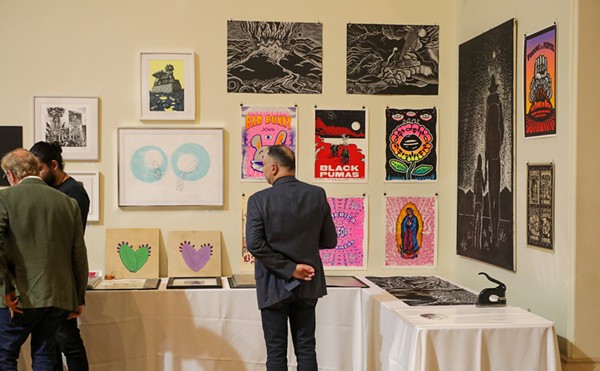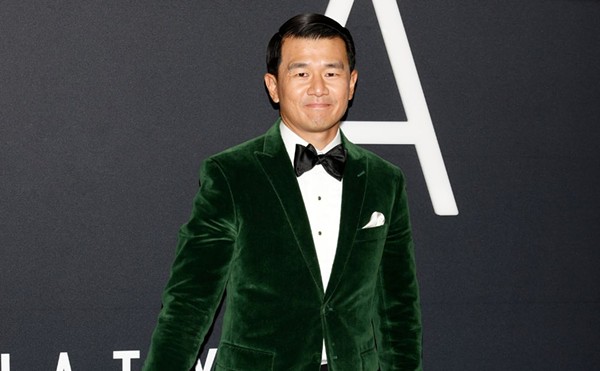A sweet suite of drawings by turn-of-the-last-century master George Bellows closes, prophetically, August 31, just ahead of FOTOSEPTIEMBRE USA, the month-long celebration of the machine-captured image. Its location, in SAMA’s cave-like, ground-floor gallery behind the gift shop, does nothing to dispell a prejudice against museums as custodians of the past. But it’d be a shame if you skipped it. Tuesday evenings are now free at the newly inviting San Antonio Museum of Art, and one of the activities that’s encouraged is sketching — always a fine idea in a gallery, but especially these past couple of months when you can first ponder what the exhibit, traveling the country from the Boston Public Library, calls The Powerful Hand of George Bellows.
To make the case, the accompanying catalog features one of the show’s most kinetic drawings on its cover: “Preaching (Billy Sunday),” the artist’s rendering of a Billy Graham and Joel Osteen predecessor, whom Bellows recorded for Metropolitan Magazine at a rally called “Christ for Philadelphia — Philadelphia for Christ.” In a vast, vaulted, rustic hall, the preacher leaps like a javelin aimed straight at the capacity crowd over the heads of four scribes seated on the elaborate stumping stage. In the front row, the well-dressed rabble’s responses range from disdain to boredom to dismay to rapture.
Most of Bellows’ work here is more static than “Preaching,” even when it relays German atrocities against the Belgians in World War I. In 1918’s “The Barricade,” German soldiers march a row of naked civilians, including women and children, in front of them as a human shield. “Return of the Useless,” from the same series, portrays broken prisoners of war brutally dumped from a train — foreshadowing the horrors of the Holocaust to come. The emotional weight of these drawings comes not from the subjects’ expressions, which are often either woodenly accurate or cartoonishly expressive, but from Bellows’ truly powerful compositions and use of chiaroscuro. In almost every frame, commotion and stillness, light and dark, substance and space are balanced in classical proportions that give the subjects — even those famous boxing images — their narrative force.
Not so the bodies, especially the hands, where this member of the Academy-shunning Ash Can crowd seems to have thrown up his hands. Often the fingers are spindly twigs; other times the mitts are distractingly chunky, as in the otherwise fantastic “Punchinello in the House of Death,” an illustration for Century magazine’s 1922 serialization of The Wind Bloweth.
That work, like several in the show, is presented as a study, a drawing, and a lithograph, which also gives working artists a chance to examine the translation of the image in closely related but distinct media: where light spreads softly in a charcoal gloom, where it’s etched hard into inkier shadows. Students of form and method will also admire the way that Bellows often worked with graphite, pen and ink, and crayon in the same drawings, giving them a painting-like depth and textural variation that effectively translates the physical matter — bricks and mortar, metal fire escapes, weathered wood — of the real world.
Maybe I’m just a softie for canines, but it’s the dogs — never the subjects here, except in one of my favorite Bellows, “Dogs, Early Morning (Hungry Dogs)” — that seem to have agency and freedom in these frozen historical vignettes. Cowering in the fire’s shadow in “The Law is Too Slow,” Bellows’ 1922-23 rendering of the 1903 lynching and burning of a black man, the animals are the repository for the artist’s horror and the humanity that’s tragically absent in the mob.
To the extent that Bellows editorialized in these documentations of heavy moral subjects, it was often oblique, the context more than the main event. Billy Sunday, of whom Bellows wrote, “Do you know, I believe Billy Sunday is the worst thing that ever happened to America?” gets comparatively dignified treatment that respects if not admires his electrical populist appeal, while the crowd appears as caricatures, fawning, fainting, climbing over each other for their chance to touch the preacher, and only occasionally demonstrating a healthy skepticism. This approach, along with the contrast between his more realistic but usually less expressive natural faces and his comical emotional players, sometimes conveys an early 20th-century tension between good-natured American optimism and the fatalism-tinged struggle of Europe and non-white America.
Which is where the “why” comes in. Much of this show, from German war crimes to the tent revivalist (about whom Bellows also said, “He is against freedeom, he wants a religious autocracy.”) to mistreated POWs will feel like everything old is new again. The real power of Bellows today is to remind us that in the age of ubiquitous digital documentation, when contemporary drawing seems to have relegated itself to the minor and quirky, human observation transmuted through a work of the hand may move people as much as another shiny collection of pixels. •
VISUAL ART
The Powerful Hand of George Bellows
10am-9pm Tue; 10am-5pm Wed-Sat; noon-6pm Sun
$3-8 general; under 3 free; free Tue 4-9pm
San Antonio Museum of Art
200 W. Jones
(210) 978-8100
samuseum.org



